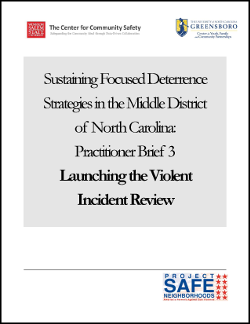
This report highlights aspects of the Violent Incident Review (VIR), a tool used to develop operationally meaningful definitions of gun violence in target communities.
The Violent Incident Review(VIR) is a tool used to develop operationally meaningful definitions of gun violence in target communities. Built upon the work of John Klofas, a professor at the Rochester Institute of Technology, and others in the Strategic Approaches to Community Safety Initiative (SACSI), a national NIJ program in Rochester, New York in developing practical processes for implementing focused deterrence efforts, the VIR process is a starting point for problem identification in Middle District of North Carolina (MDNC) Project Safe Neighborhoods (PSN) sites. VIRs bring all participants in a local criminal justice system together, from local agenciessuch as police, prosecutors, probation, and parole, to federal agencies like the Drug Enforcement Administration; Federal Bureau of Investigation; Alcohol, Tobacco, Firearms and Explosions; and U.S. Attorney’s offices in a review of recent cases for the dual purposes of (a) gaining new information and insight into violent crime trends within a community, and (b) facilitating communication between criminal justice agencies (Klofas & Delaney, 2002). The VIR process compels each agency to share known information about incidents of crime, including, but not limited to, related circumstances and motives, related incidents, location context information, and information concerning suspects and victims (e.g., prior arrest and conviction histories, pending charges, current probationary status, gang affiliation, and friends and acquaintances). The review can culminate in development of criteria for notification within a PSN site, identification of notification participants, identification of offenders for swift prosecution and sanctions, and development of related intervention strategies that may or may not include a notification. Although the VIR process involves several mandatory components, the process does vary from site to site to adjust for lessons learned and specific site dynamics as they may relate to incorporating data from multiple agencies and the capacity of those agencies to provide data and convene for review meetings.
